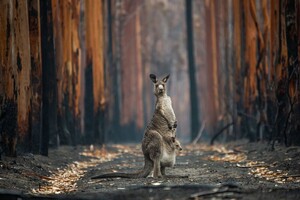The age of the animal is estimated at 50 thousand years.

Long ago, almost until the end of the last Ice Age, giant kangaroos lived in the rainforests of New Guinea. So far, a team of scientists led by Isaac Alan Robert Kerr of Flinders University has found that these animals were not related to modern Australian animals. Most likely, they belonged to a previously unknown type of kangaroo, unique to New Guinea, according to an article published in Science alert.
Read also: Scientists have found in Australia a rock painting of a kangaroo aged 17 thousand years
In the past, Australia was home to giant animals called megafauna. They lived on the continent next to the species that are characteristic of it now, but they were also much larger. At the same time, 40,000 years ago, most megafauna became extinct.
The fossil megafauna of New Guinea is much less studied, but even what is known now suggests the existence of amazing and unusual animals whose evolutionary stories intertwine with those of Australia. p>
During excavations led by Mary-Jane Mountain in the early 1970s, the jaws of a giant extinct kangaroo were discovered. Young researcher Tim Flannery named the species Protemnodon nombe.
The age of the fossils described by Flannery is 20-50 thousand years. They were found in the Nombe Stone Shelter, an archeological and paleontological monument in the mountains of central Papua New Guinea. Fossils of another kangaroo and giant four-legged marsupials called diprotodontids have also been found in the area.
In a new study, scientists re-examined the fossil of Protemnodon nombe and found something unexpected. This kangaroo was not a member of the genus Protemnodon, which previously lived throughout Australia. It was something much more primitive and unknown.
Yes, unusual molars with curved enamel combs were different from other known kangaroos. As a result, the researchers placed the animal in a new genus unique to New Guinea and named it Nombe nombe.
According to scientists, this genus comes from an ancient form of kangaroo that migrated to New Guinea from Australia about 5-8 million years ago. At that time, New Guinea and Australia were connected by a land bridge. He allowed early Australian animals, including megafauna, to migrate to the rainforests of New Guinea. When the Torres Strait was flooded again, these animal populations broke away from their Australian relatives and evolved separately to adapt to their tropical and mountain home.
Scientists believe that Nombe nombe was a descendant of one of these ancient kangaroo lines. The squat muscular animal lived in a mountain rainforest with dense undergrowth and a closed canopy. It was adapted to feed on the hard leaves of trees and shrubs, which gave it a thick jaw and strong masticatory muscles.
Currently, the species is known only for its two lower jaws, so scientists still have much to learn about it. For example, did he move by jumping, like modern kangaroos. It is also unknown why this ancient animal became extinct.




